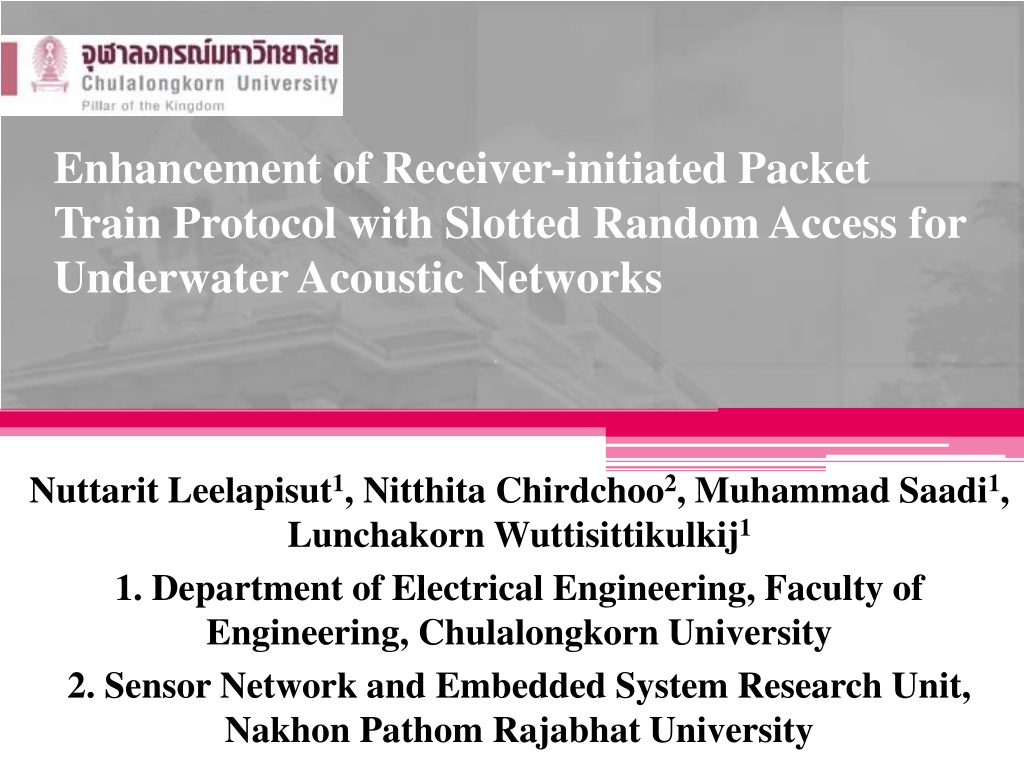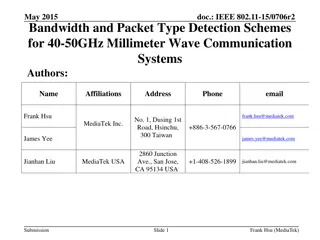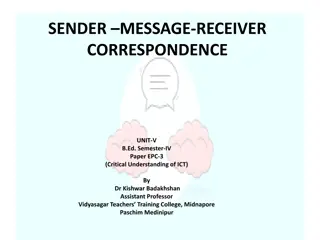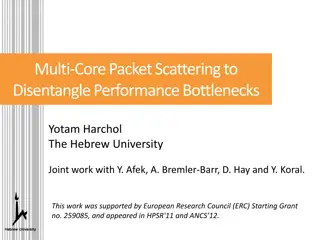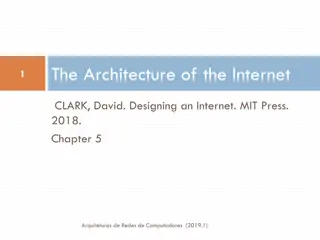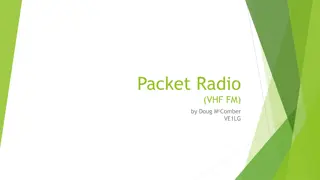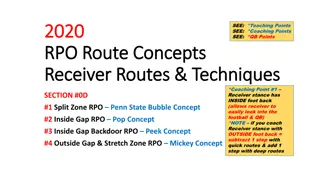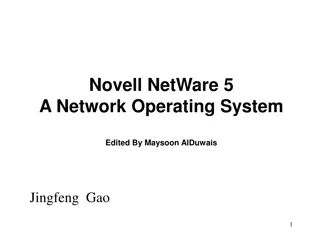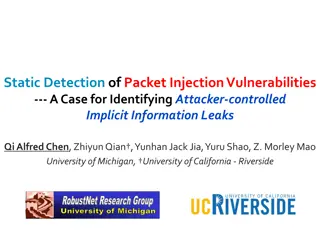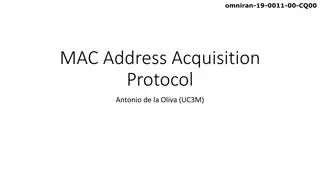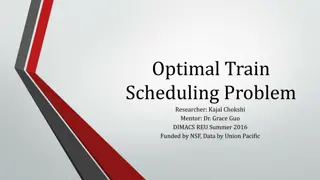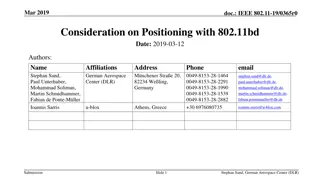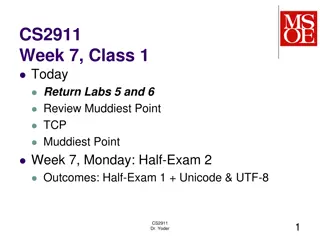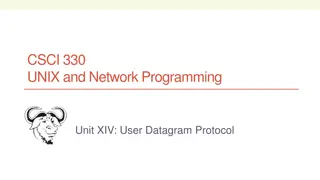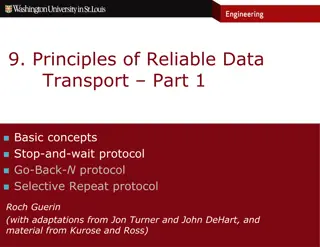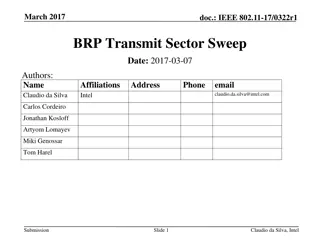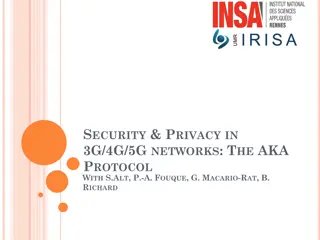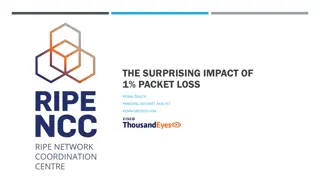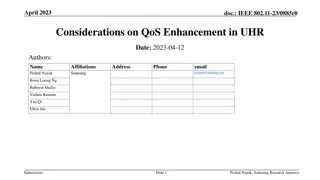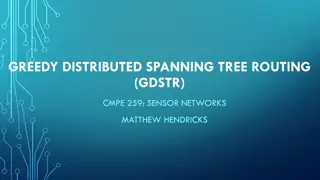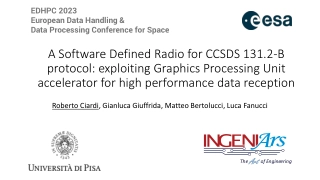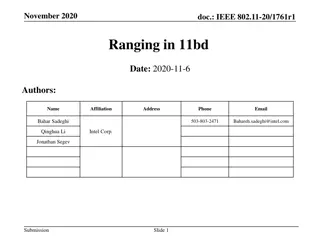Enhancing Receiver-Initiated Packet Train Protocol for Underwater Acoustic Networks
This study focuses on enhancing the Receiver-Initiated Packet Train Protocol with Slotted Random Access for Underwater Acoustic Networks. The research explores the challenges of underwater communication, the characteristics of underwater sensor networks, and the RIPT protocol along with its improvements such as E-RIPT. The proposed enhancement aims to increase channel utilization and address issues related to hidden terminal problems and inter-node propagation delays.
Download Presentation

Please find below an Image/Link to download the presentation.
The content on the website is provided AS IS for your information and personal use only. It may not be sold, licensed, or shared on other websites without obtaining consent from the author. Download presentation by click this link. If you encounter any issues during the download, it is possible that the publisher has removed the file from their server.
E N D
Presentation Transcript
Enhancement of Receiver-initiated Packet Train Protocol with Slotted Random Access for Underwater Acoustic Networks Nuttarit Leelapisut1, Nitthita Chirdchoo2, Muhammad Saadi1, Lunchakorn Wuttisittikulkij1 1. Department of Electrical Engineering, Faculty of Engineering, Chulalongkorn University 2. Sensor Network and Embedded System Research Unit, Nakhon Pathom Rajabhat University
2 Outline Introduction Protocol Design Simulation & Results Summary
3 Introduction Why Underwater? The ocean covers 71% of the Earth's surface and contains 97% of the planet's water. more than 95% of the underwater world remains unexplored. Example of Application in underwater Pollution monitoring Offshore exploration Oceanographic data collection
4 Underwater Communication Characteristics Most underwater sensor networks are based on acoustic waves. Propagation speed 1500m/s Lead to long propagation delay 0.67s/km Scarce bandwidth availability Lead to low datarate a few kbps Terrestrial MAC protocols cannot be applied directly to Underwater Acoustic Networks. Example for MAC for Underwater Acoustic Network MACA-U, RIPT, SF-MAC, CS-MAC, Aloha-AN
5 RIPT RIPT was proposed by Chirdchoo et al.(2008) is handshaking with Receiver-initiated protocol. with packet train that can send more than one DATA packet in each handshake round.
6 RIPT Strong More effective in term of alleviating the hidden terminal problems. Weakness Each node must know the inter-node s propagation delay of all other nodes. RIPT protocol adapt the frame size of data transmission period according to the number of data packets from the previous handshaking round. May be not match with current traffic demand Cause low Throughput
7 E-RIPT E-RIPT is from Enhance RIPT Main point of E-RIPT protocol Use the slotted random access at reservation time. Reduce the requirement of original RIPT that need to know all inter-node propagation delay Set frame size after received traffic demand from neighboring node. Increase channel utilization
8 Node Type Beacon node Process and Control the Slave node(s). Receive DATA packet(s) from Slave node(s). Slave node Reserve the data slot which declare from beacon Send DATA packet to Beacon node Idle node Node which wait for changing type
9 Silent Slave E-RIPT Protocol REV NTF1 REV-ACK Slave ORDER BROADCAST NTF2 Beacon Slave Slave DATA Sall= 4 Node 4 Slave Node 2 Slave Node 1 Beacon Node 3 Slave Node 5 Slave Node 6 Silent tout1 REV Beacon node ID No reservation Slot tout1 NTF1 Time till tout1 tout1 REV-ACK Number of packet wish to send Time till tout1 ORDER Time and Number of DATA packet(s) for Slave to send. tout1 tout1
10 Silent Slave E-RIPT Protocol REV NTF1 REV-ACK Slave ORDER BROADCAST NTF2 Beacon Slave Slave DATA Sall= 4 Node 4 Slave Node 2 Slave Node 1 Beacon Node 3 Slave Node 5 Slave Node 6 Silent tout2 tout2 tout,b tout2 tout2 tout2 tout1 NTF2 Time till tout2
11 Simulation Model We used open source simulator NS-3, with UAN module. Simulation model is the same as RIPT simulation model. 36 nodes each node has 8 1-hop neighboring nodes 16 2-hop neighboring nodes Wraparound Deviate from intersection point a maximum 10% in x and y direction Datarate = 2400 bps DATA packet length = 2400 bit Grid Spacing = 700m We choose to benchmark our protocol with RIPT and MACA-U
12 Result-Throughput 0.02 Normalized throughput per node 0.015 RIPT MACA-U E-RIPT Sall = 2 E-RIPT Sall = 4 E-RIPT Sall = 8 E-RIPT Sall = 10 E-RIPT Sall = 12 E-RIPT Sall = 14 E-RIPT Sall = 16 0.01 0.005 0 0 0.01 0.02 0.03 0.04 0.05 0.06 0.07 Normalized offered load per node Sall= No. 1-hop neighboring node
13 Result-Delay 5000 4500 End-to-End packet delay (seconds) 4000 3500 3000 RIPT MACA-U E-RIPT with Sall = 2 E-RIPT with Sall = 4 E-RIPT with Sall = 8 E-RIPT with Sall = 10 E-RIPT with Sall = 12 E-RIPT with Sall = 14 E-RIPT with Sall = 16 2500 2000 1500 1000 500 0 0 0.01 0.02 Normalized offered load per node Sall= No. 1-hop neighboring node 0.03 0.04 0.05 0.06 0.07
14 Result-Fairness RIPT E-RIPT Sall= 8 4 4 5x 10 5x 10 4 4 3 3 2 2 1 1 0 0 0 10 20 30 0 10 20 30 MACA-U 4 2.5x 10 Number of packets sent with offerload per node = 0.503 RIPT, Mean = 38528.1389, SD = 4922.9368 E-RIPT Sall= 8, Mean = 41608.8056, SD = 3470.5466 MACA-U, Mean = 18598.6944, SD = 906.4938 2 1.5 1 0.5 0 0 10 20 30
15 Summary E-RIPT can reduce the requirement of original RIPT by using slotted random access. can decrease the time latency, improve throughput and fairness of original RIPT protocol, if reservation slots are selected carefully.
16 Q & A
17 Thank you
